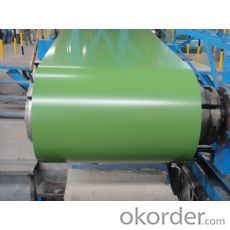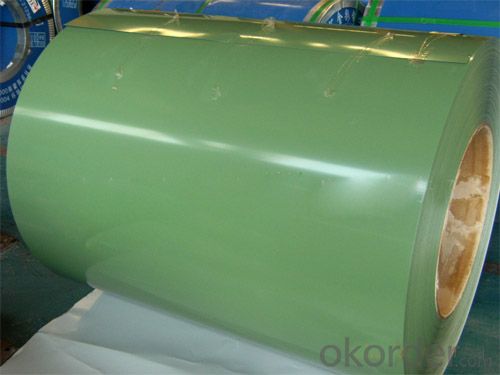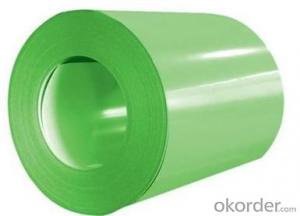Pre-painted Galvanized/ Aluzinc Steel Sheet Coil with Prime Quality and Lowest Price
- Loading Port:
- Shanghai
- Payment Terms:
- TT OR LC
- Min Order Qty:
- 100 m.t.
- Supply Capability:
- 10000 m.t./month
OKorder Service Pledge
OKorder Financial Service
You Might Also Like
1.Structure of Pre-painted Galvanized/Aluzinc Steel Coil Description
Pre-painted galvanized steel is good capable of decoration, molding, corrosion resistance. It generally displays workability, durability and weather resistance.
2.Main Features of the Pre-painted Galvanized/Aluzinc Steel Coil
• Excellent corrosion resistance
• Excellent weather resistance
• Excellent heat resistance performance
• High strength
• Good formability
• Good visual effect
3.Pre-painted Galvanized/Aluzinc Steel Coil Images


4.Pre-painted Galvanized/Aluzinc Steel Coil Specification
Quality standar: JIS G3312 CGCC & CGLCC
Hardness of P: Both soft and hard quality are available
Width : 914mm, 1000mm, 1220mm and 1250mm, thickness 600-1250mm is available
Surface finish: with or without protect film
Thickness : 0.14-1.20 mm
Finish by coil or sheet: Both sheet and coil are available
8Zinc coating: 60-275G/M2, both sides
Paint thickness for top side : 5 micron primer + (10-20) microns modified polyester, any RAL color code.
Paint thickness for back side: (5-10) microns Epoxy
Weight per coil: 4-6 tons, also can be upon customer's requirements
Max loading weight in one 20ft container : 25 tons generally
5. FAQ of Pre-painted Galvanized/Aluzinc Steel Coil
We have organized several common questions for our clients,may help you sincerely:
What is the minimum order quantity ?
And we will consider to give more discount if you make big order like 2000 tons and more.
- Q:How are steel coils used in the production of automotive components?
- Steel coils are used in the production of automotive components as they are rolled into flat sheets and then further processed to create various parts such as body panels, frames, and chassis. These coils provide the necessary strength and durability required for automotive applications, ensuring the safety and performance of vehicles.
- Q:How is it used easy 10 points just tell me how its used or any intersting facts this is for my comp science paper lol. I know what the hell does steel have to too do with computers he is a Fg! Please be descriptive THANKS! FAST ANSWERS TOO it 9pm bedtime for a 14 year old lol..
- steel is used for cars and trains. one of the largest steel manufacturers is in my town its called CarTech its in reading pa.
- Q:How are steel coils used in the manufacturing of industrial compressors?
- Steel coils are used in the manufacturing of industrial compressors primarily for the construction of the compressor's casing and frame. The steel coils are shaped, cut, and welded to create the sturdy and durable structure that houses the compressor components. Additionally, the steel coils may also be used in the fabrication of other parts such as motor mounts or brackets, contributing to the overall reliability and stability of the compressor.
- Q:What is the type of stainless steel used in knifes.
- There okorder / Stainless steel doesn't make the best knife blade. It doesn't sharpen as sharp or hold its edge as well. High carbon steel is better, but it rusts and discolors very easily so it's not as popular. A new thing (actually not new but popular these days) is to use a 'sandwich' of high carbon steel between two layers of stainless. So the actual edge is high carbon steel but the blade looks like stainless. I have some kitchen knives made this way (kind of expensive) and I love them. This same technique was used in Japanese katanas, swords used by samurai warriors.
- Q:What are the dimensions of steel coils used in bridge construction?
- The dimensions of steel coils utilized in the creation of bridges can fluctuate depending on the precise requirements of the bridge undertaking. However, in general terms, the dimensions of steel coils used in bridge construction typically fall within the range of 0.5 to 1 inch in thickness and 36 to 72 inches in width. The length of the coils may also differ, but is commonly around 20 to 40 feet. These dimensions enable the production of various fundamental structural elements, such as beams, columns, and plates, which are indispensable for bridge construction. It is noteworthy that the dimensions may vary based on the specific design and engineering specifications of the bridge project, as well as the type and load capacity of the bridge being constructed.
- Q:How are steel coils used in the manufacturing of structural components?
- Steel coils are used in the manufacturing of structural components by being processed through various techniques such as cutting, bending, and welding to form the desired shapes and sizes. These coils serve as the raw material for fabricating beams, columns, and other structural elements used in buildings, bridges, and infrastructure projects. The high strength and durability of steel make it an ideal choice for constructing load-bearing components, ensuring the stability and integrity of the structures.
- Q:I also heard Stainless holds up better againts rust, blue steel needs more care.
- Stainless steel requires less maintenance, but I've got a K-38 Combat Masterpiece from 1974. Back then SW used the real blueing process, and the blue steel looks like its a foot deep. Probably the best looking gun in the accumulation. Still new in the box, never fired. Its my Vietnam tribute gun, same one I carried as a Security Policeman in the Air Force from 1969-1971.
- Q:Which steels were origianally designed to be used to cut and shape metals and other materials?- alloy steel- high carbon steel- carbide steel- tool steelthanks
- Strength of metals is normally measured by the tensile strength as the main measure although this is not the only property as hardness is another big factor. Basically, iron is soft and steel is hard. Plain iron is stretchy and does not corrode quickly, whereas steel is much stiffer and corrodes more quickly. The tensile strength of cold worked iron is about half that of an average steel, likewise the hardness is about half that of steel too. Pure iron, which is rarely used, is even weaker and softer again and a bit more like softer materials like copper and aluminium. Where confusion comes in is that there is another iron - Cast Iron - which is totally different to both iron and steel. Cast iron is very hard and tough but incredibly brittle so its properties are very different.
- Q:How are steel coils tested for compliance with industry standards?
- Steel coils are tested for compliance with industry standards through a series of rigorous quality control measures. These tests are conducted to ensure that the coils meet the necessary specifications and are suitable for use in various applications. One of the primary tests performed on steel coils is the dimensional inspection. This involves measuring the thickness, width, and length of the coils to ensure they meet the specified tolerances. Any deviations from the required dimensions can indicate a manufacturing defect or potential issues during fabrication. Another critical test is the visual inspection, where trained inspectors carefully examine the coils for any surface defects such as scratches, dents, or cracks. These defects can affect the performance and durability of the steel coils, making it essential to identify and rectify them before they are supplied to customers. Furthermore, mechanical properties testing is conducted to assess the strength, elasticity, and toughness of the steel coils. This includes tests like tensile strength, yield strength, and elongation measurements. These tests help determine the suitability of the coils for specific applications and ensure they meet the required performance standards. Additionally, chemical composition analysis is performed to verify the elemental composition of the steel coils. This analysis is crucial as it ensures that the steel meets the required chemical requirements, including the presence of specific alloying elements. Deviations in composition can impact the overall quality and performance of the coils. Corrosion resistance testing is also important, especially for coils used in environments with high humidity or exposure to corrosive substances. Coils are subjected to salt spray or humidity chambers to simulate real-world conditions and evaluate their resistance to corrosion. Lastly, various non-destructive testing techniques, such as ultrasonic testing and magnetic particle inspection, are used to detect internal defects or discontinuities in the steel coils. These tests help identify any hidden flaws that may compromise the structural integrity of the coils. Overall, steel coils undergo a comprehensive range of tests to ensure compliance with industry standards. By conducting these tests, manufacturers can guarantee that the coils meet the required specifications, providing customers with high-quality products that meet their specific needs.
- Q:How are steel coils inspected for camber using laser profiling?
- The inspection of steel coils for camber involves the use of laser profiling, a measurement technique that does not require physical contact. Laser profiling works by emitting a laser beam onto the surface of the steel coil, creating a detailed profile of its surface. To detect camber, the laser profiling system scans the entire length and width of the coil, capturing data points at regular intervals. These data points are then analyzed to determine the deviation from a straight line, indicating the presence of camber. During the inspection process, the measured profile of the steel coil is compared to a reference profile, which represents an ideal or straight surface. The deviation between the measured profile and the reference profile is calculated, and if it exceeds a predetermined threshold, the coil is flagged as having camber. The use of laser profiling offers several advantages for camber inspection of steel coils. Firstly, it eliminates the need for physical contact, reducing the risk of damage. Additionally, laser profiling is highly accurate, capable of detecting even small deviations in the coil's surface. This ensures reliable detection of camber, allowing for necessary corrective actions to be taken. Overall, laser profiling is an efficient and accurate method for inspecting steel coils for camber. It enables manufacturers to maintain high-quality standards and deliver reliable products to customers.
1. Manufacturer Overview |
|
|---|---|
| Location | |
| Year Established | |
| Annual Output Value | |
| Main Markets | |
| Company Certifications | |
2. Manufacturer Certificates |
|
|---|---|
| a) Certification Name | |
| Range | |
| Reference | |
| Validity Period | |
3. Manufacturer Capability |
|
|---|---|
| a)Trade Capacity | |
| Nearest Port | |
| Export Percentage | |
| No.of Employees in Trade Department | |
| Language Spoken: | |
| b)Factory Information | |
| Factory Size: | |
| No. of Production Lines | |
| Contract Manufacturing | |
| Product Price Range | |
Send your message to us
Pre-painted Galvanized/ Aluzinc Steel Sheet Coil with Prime Quality and Lowest Price
- Loading Port:
- Shanghai
- Payment Terms:
- TT OR LC
- Min Order Qty:
- 100 m.t.
- Supply Capability:
- 10000 m.t./month
OKorder Service Pledge
OKorder Financial Service
Similar products
New products
Hot products
Related keywords




























